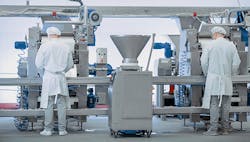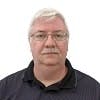I recently returned from a trip to the west coast, where we checked out a new palletizer for one of our permanent production lines. In the life of a co-packer, the opportunity to set up a permanent production line is a rare breath of fresh air.
While we approach all production opportunities with the same basic approach, being able to plan a layout in advance, where we get to choose the specific product flow and there is room to space out the various unit operations that make up the production line is especially satisfying.
Also read: The future of linear-motion technology
This particular packaging line has special significance for me. I was sidetracked by a serious encounter with COVID-19 very early in the pandemic. Only a few months into battle here in the United States, the virus was still relatively unknown and treatments were in the infant stages.
As a food producer, ours was an essential service and our employees bravely continued to come to work so that others could have food on the table. As it happens, my last work in the plant, before my encounter with the virus, was the initial commissioning of a brand-new cereal line. Looking back, that might have been my last effort in the world of automation, or in this world, period, had it not been for a stellar effort on the part of the doctors and nurses during my battle back to health.
During that spring and summer of 2020, we were also expanding our operations with three purpose-built production rooms. Being able to design from the ground up is something that is normally reserved for the main line food producers in their own plants.
As a co-packer, we are usually tasked with trying out new processes that end up in the parent plants or producing other private-label products that come our way. The cereal line was one of three rooms that we were commissioning when the pandemic hit.
Food production has become more challenging over the past few years. Facilities that were built in the middle of the last century weren’t made with allergens in mind. They tend to have a small footprint and relied on people using a minimum of machinery to make products for their customers.
The buildings were generic in nature and were adapted, after the fact, to suit the needs of the company as the core capabilities and client base grew. Happily growing as needs grow, a building from 1965 isn’t well-suited to the demands of modern manufacturing processes.
In 2019, we decided to section off a piece of our large warehouse facility and purpose-build three rooms to handle new production. One room would be dedicated to a cereal co-packing line; a second room would house a cup filling line that we had packed into very cramped quarters in our main facility; and the third would house a homegrown product line, the first in the storied history of this proud co-packer.
I bring all this up because it’s great to see a vision come to reality. The work with the architect on the plans for these three rooms, the conceptual layouts of the process equipment upstairs and production lines downstairs, the impact on the warehouse, potential workflows and materials movement, and the selection of equipment to make this all happen was a culmination of more than 32 years of experience in this wonderful industry.
I was determined to see it through and doggedly worked on commissioning the first line when the impact of the virus overcame my ability to ignore the symptoms anymore. Stubborn guy that I am, I spent the next 18 days in the hospital, texting and emailing from a segregated ward while my teammates picked up the pace and had us co-packing cereal by the time that I was able to come home.
The checkout of a new piece of packaging machinery is always an exciting event. We spend months poring over concepts, quotes, purchase orders and approval drawings.
Finally, we get to go to the vendor and see our vision come to life. It is also an excellent opportunity to get to know the people behind the product and learn more about the capabilities of the company that might be beyond the machine that has been purchased.
We get to see what other people are doing with the same machine or family of machines. It is an opportunity to expand on the vision of our own facility and processes and be inspired by what else is out there in the world of automation.
For me, I often get a chance to see that the world of automation really is rather small. Conversations with the people in the plant often reveal that we have shared paths, and, while I’m an end user now, some of their customers were once my customers. I miss the personal interaction with people, and it was exciting to feel that, as we recover from the pandemic, we will get to see more of people in person.
Technology is always a big part of my focus during a factory acceptance test. While I am interested in how others use the same products that I have in my designs, I am even more interested in what technology might be in use that I haven’t even considered before.
It takes a concerted effort during the quoting process to present standards that aren't so restrictive that innovation is curtailed. Just because I have had success with a specific brand or type of hardware, doesn’t mean that others might not have a better way to do things. I always come away from these events with a new sense of purpose, and I am inspired to do some homework to see how what I have seen might be applied to future projects.
One such source of inspiration was my recent encounter with the advances in linear motion. Many of my earlier experiences with linear motion were the application of a rotary motor to move belts that created linear motion.
While this is a good way to create linear motion, there are many limitations to this technology. Belts are flexible, and there is only so much speed that can be achieved by this method. Actions that require a quick return to the start position put wear and tear on the belts, which leads to deteriorated movement over time.
Linear-motion technology has improved greatly over the past few years. While there are many brand names in the industry, the development of electromagnetic motion has made the biggest impact on the application of linear motion. Sometimes called magnetic conveyance, the concept is to mount a pallet on a pair of linear rails. The pallet has a permanent magnet that reacts to electromagnetic coils in the base between the linear rails.
A magnetic encoding strip on each pallet is picked up by finely located magnetic encoders on the linear rail to provide motion feedback. Velocity and position can be closely monitored for each individual pallet, allowing for accurate, independent motion of each pallet.
With this technology, pretty much anything can be mounted to each pallet. They can be mounted in any orientation and can move products in specific paths that don’t need to be in a straight line. For this reason, a number of machine builders are using this technique to move pallets, sometimes called puck, through the various stations of a machine or process.
This technology appears in horizontal pouching machines where an empty pouch—pre-formed or formed in on infeed section ahead of this—is presented to clips mounted to a puck that then moves through various stations in the filling section to get opened, filled and sealed before getting pulled off at the end of the filling section.
The pucks then race around the back section of the machine to be ready to accept a new pouch. Because of the independent movement of the pucks when not in the production path, more stations can be located within the production loop than on a conventional pouching machine, where each station is a fixed distance apart on carrier chains. This means faster production within the same producing envelope and more machine throughput.
The pucks also move independent to each other, so velocity and acceleration can be independently controlled to limit the product splash and pouch distortion that happens when moving product too fast in a conventional machine.
Another application of this technology would be in a horizontal orientation where various stations—stops along the path—perform different functions on the base product. This can be used to produce electronic boards or micro-assembly of objects.
In a larger format, this can be used to move items through a machine center to mass-produce parts. Due to the independent movement and assignment of each puck/pallet, each part could selectively receive attention at the various stations or could even depart on a secondary path, depending on the manufacturing assignment applied to each puck. In this application, each puck would employ a radio-frequency-identification (RFID) tag to provide processing information that the various stations and “traffic cops” along the path would follow to direct the pucks accordingly.
Technology is ever-evolving, and it’s very important to take the time to look beyond the current point of view to learn what’s coming down the track.
Rick Rice is a controls engineer at Crest Foods, a dry-foods manufacturing and packaging company in Ashton, Illinois. With more than 30 years’ experience in the field of automation, Rice has designed and programmed everything from automotive assembly, robots, palletizing and depalletizing equipment, conveyors and forming machines for the plastics industry but most of his career has focused on OEM in the packaging machinery industry with a focus on R&D for custom applications. Contact him at [email protected].
About the Author
Rick Rice
Contributing Editor
Rick Rice is a controls engineer at Trew Automation, a material handling manufacturer based in West Chester, Ohio. With over 38 years’ experience in the field of automation, Rice has designed and programmed everything from automotive assembly, robots, palletizing and depalletizing equipment, conveyors and forming machines for the plastics industry but most of his career has focused on OEM in the packaging machinery industry with a focus on R&D for custom applications.

Leaders relevant to this article:


